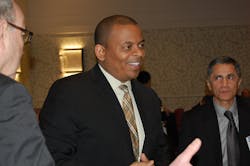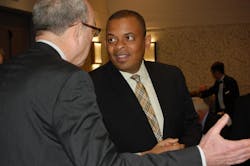Anthony Foxx, the outgoing Secretary of Transportation, stressed in an “exit memo” issued this week that improving and expanding America’s transportation system – especially its highway network – will remain a big issue for his replacement, Elaine Chao, who is expected to be confirmed by the U.S. Congress next week.
“The next Secretary of Transportation will not simply work on building roads and bridges and ensuring safe travel,” Foxx said in his memo.
“The next administration is entering a period of advanced automated technologies in transportation, an infrastructure system that continues to work for some and against others in society, dramatic demographic shifts, an increase in extreme weather events in a changing climate, and a backlog of projects needed across the country with not enough resources to address it,” he added.
Foxx – who previously served as the Mayor of Charlotte, NC, before becoming Transportation Secretary in 2013 – stressed that the main current funding source for highway construction and repair, the federal fuel tax, “does not meet our infrastructure needs and is getting weaker each year [and] future administrations should consider fundamentally rethinking transportation funding.”
He added that among the challenges the current transportation system faces in the future include a rapidly growing population, demographic shifts in rural and urban areas, and a 45% increase in freight volume – issues touched on in the agency’s Beyond Traffic 2045 report issued last year.
“In recent decades, investments have failed to keep pace with increasing needs and much of our infrastructure has fallen into disrepair,” Foxx noted. “New policies are needed to generate sufficient revenues to meet the needs of our transportation system, prioritize funding to cost-effectively improve mobility, and incentivize efficiency and performance.”
Other key trends Foxx touched on in his “exit memo” include:
- More work needs to be done to combat the growing danger of distracted driving, he said. According to DOT data, the problem is increasing and in 2015, 3,477 people were killed and 391,000 were injured in distracted driving crashes within the U.S. “Research also shows that texting while driving makes it 23 times more likely a driver could end up in a crash,” Foxx emphasized.
- More “innovation” for transportation will occur at the local level, with the help of federal funding. Since September 2015, the Department of Transportation (DOT) has “leveraged” $350 million in federal, local, and private funding to show how vehicle-to-vehicle (V2V) and automated vehicle technologies can change cities and local communities, he said. “Through the Smart City Challenge, 78 cities competed for funding to execute their visions for the future of urban transportation. The winning city –Columbus, Ohio – will combine $40 million in DOT funding with approximately $100 million in funding through public-private partnerships to pilot advanced technologies that will change the face of urban transportation.”
- Government needs to keep “rewiring” itself in order to become more supportive of new technologies, like autonomous vehicles, while ensuring such technologies are safe and secure. “This is both an opportunity and a challenge,” Foxx said. “Technological changes are coming fast and with greater frequency. Whether it is drones being used for delivering packages to driverless vehicles on our roadways, to proposed Hyperloop transport, the DOT needs to be prepared to react quickly, nimbly, and proactively in order to shape positively the way these technologies transform our transportation system.”
About the Author
Sean Kilcarr
Editor in Chief
Sean Kilcarr is a former longtime FleetOwner senior editor who wrote for the publication from 2000 to 2018. He served as editor-in-chief from 2017 to 2018.

